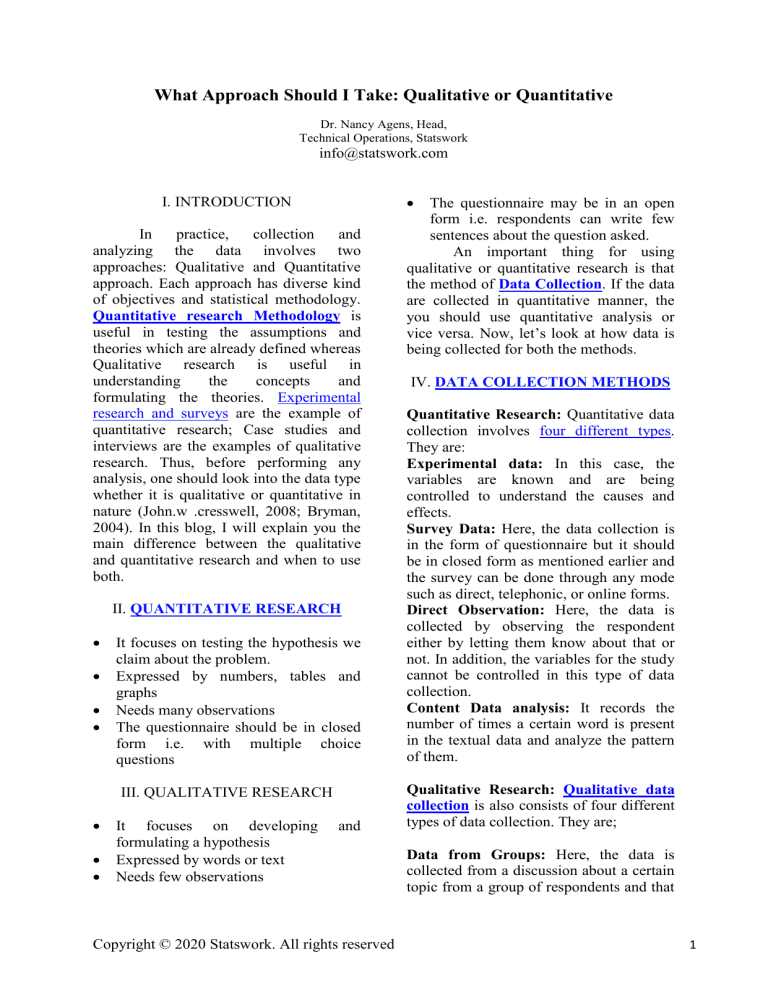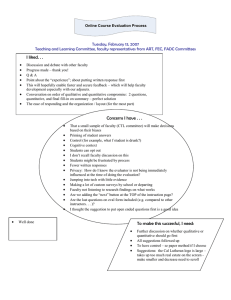
What Approach Should I Take: Qualitative or Quantitative Dr. Nancy Agens, Head, Technical Operations, Statswork info@statswork.com I. INTRODUCTION In practice, collection and analyzing the data involves two approaches: Qualitative and Quantitative approach. Each approach has diverse kind of objectives and statistical methodology. Quantitative research Methodology is useful in testing the assumptions and theories which are already defined whereas Qualitative research is useful in understanding the concepts and formulating the theories. Experimental research and surveys are the example of quantitative research; Case studies and interviews are the examples of qualitative research. Thus, before performing any analysis, one should look into the data type whether it is qualitative or quantitative in nature (John.w .cresswell, 2008; Bryman, 2004). In this blog, I will explain you the main difference between the qualitative and quantitative research and when to use both. II. QUANTITATIVE RESEARCH It focuses on testing the hypothesis we claim about the problem. Expressed by numbers, tables and graphs Needs many observations The questionnaire should be in closed form i.e. with multiple choice questions III. QUALITATIVE RESEARCH It focuses on developing formulating a hypothesis Expressed by words or text Needs few observations and Copyright © 2020 Statswork. All rights reserved The questionnaire may be in an open form i.e. respondents can write few sentences about the question asked. An important thing for using qualitative or quantitative research is that the method of Data Collection. If the data are collected in quantitative manner, the you should use quantitative analysis or vice versa. Now, let’s look at how data is being collected for both the methods. IV. DATA COLLECTION METHODS Quantitative Research: Quantitative data collection involves four different types. They are: Experimental data: In this case, the variables are known and are being controlled to understand the causes and effects. Survey Data: Here, the data collection is in the form of questionnaire but it should be in closed form as mentioned earlier and the survey can be done through any mode such as direct, telephonic, or online forms. Direct Observation: Here, the data is collected by observing the respondent either by letting them know about that or not. In addition, the variables for the study cannot be controlled in this type of data collection. Content Data analysis: It records the number of times a certain word is present in the textual data and analyze the pattern of them. Qualitative Research: Qualitative data collection is also consists of four different types of data collection. They are; Data from Groups: Here, the data is collected from a discussion about a certain topic from a group of respondents and that 1 can be taken for the further research about the opinions. Interview: In this case, the data is in the form of open end questionnaire and the people should respond it with a few sentences in words. Case Studies: Here, the data collection involves a specific event, or group or an organization. Review of Literature: In this case, the data is collected or surveyed from other published works related to the study. Apart from the data collection methods, a rule thumb for selecting between qualitative and quantitative research is that, If you wish to test something (hypothesis testing) then go for quantitative research If you wish to understand something (concepts) then go for qualitative research Now let me explain the two researches by means of an example. First let us develop a research problem. Here I am interested in studying the satisfaction of students with their studies in the University. For Quantitative method, I will collect or survey 400 samples of students from the university and ask them to answer for the satisfaction they got with their professors teaching on a scale from 1-5. Then, with the collected data, statistical data analysis is performed and I can draw conclusions. For example, the students got satisfaction in their professors on an average of 4.5. For Qualitative method, I will select few students say 30 students and ask for the satisfaction in their studies with few open ended questions. The students write their opinion verbally and those are then used for analyzing the patterns of satisfactions. Let’s take an example where a market researcher wants to identify the relationship between the online purchasing behaviour and use of shopping websites using qualitative and quantitative method. In Quantitative Research, the hypothesis or the test problem can be Copyright © 2020 Statswork. All rights reserved written as there is no significant difference between the customers who purchase an item without adding it in a cart and the customers who place an item in a cart and leave the website. Then the data is collected by conducting some interviews regarding why the customers adds the items in the cart and leaves without placing an order? Then with the statistical analysis, the conclusion can be drawn (Creswell, 1999). In qualitative research, the same problem can be taken in several ways like identifying the patterns of customers who leaves a website without shopping with the online survey data, or the reason for leaving out without purchasing may be there is no trial experience of the product like we do in stores, etc. In this sense, a sample of data can be collected and then proceed with detecting the patterns of the causes and effect of the study. Here I will list out few merits and demerits of quantitative and qualitative research. V. MERITS OF QUANTITATIVE RESEARCH Since quantitative research is of numeric in nature, the results cannot be mis-interpreted. The performance of statistical analysis is easier to do Time taken for data collection is low The results can be generalized to the population VI. DEMERITS OF QUANTITATIVE RESEARCH Needs large sample for valid inference Since the responses are numeric, the meaning of the question may not be fully achieved. Create a bias problem Questions should be asked in a write way to avoid misleading results. 2 VII. MERITS OF QUALITATIVE RESEARCH It allows to explore in detailed manner Questions make the study to avoid bias in respondents Develop the creativity or ideas for improving the needs of the study Requires small samples VIII. DEMERITS OF QUALITATIVE RESEARCH Difficulty in classifying the answers Generalization is not possible It cannot be repeated because the view of problem will change over the period of time. To sum up, quantitative methods provide generalized results and it consider as a valid one. But it doesn’t mean you should use only the quantitative method. The choice between the qualitative and quantitative research is up to you. Make a clear decision of choosing the research method by defining the exact research problem and the method of data collection and go for the suitable Research Methodology. REFERENCES [1] Bryman, A. (2004). Social Research Methods. [Online]. Oxford: Oxford University Press Inc. Available from: https://books.google.co.in/books?id=GYrUQgAA CAAJ&dq=Bryman,+A.+(2004).+Social+research +methods+(2nd+ed.).+Oxford:+Oxford+Universit y+Press&hl=en&sa=X&ved=0ahUKEwiEr4mG5s jnAhXZ4zgGHQJCDSQQ6AEIKTAA. [2] Creswell, J.W. (1999). Mixed-Method Research. In: Handbook of Educational Policy. [Online]. Elsevier, pp. 455–472. Available from: https://linkinghub.elsevier.com/retrieve/pii/B9780 12174698850045X. [3] John.w .cresswell (2008). Research Desigh. [Online]. Available from: http://englishlangkan.com/produk/E Book Research Design Cressweell 2014.pdf. Copyright © 2020 Statswork. All rights reserved 3
